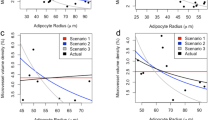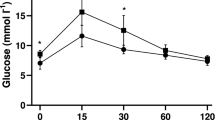Summary
The white and red regions of the iliofibularis muscle of the lizard Dipsosaurus dorsalis were analyzed using histologic and morphometric analysis. These regions are composed of fast glycolytic (FG) and both fast oxidative, glycolytic (FOG) and tonic fibers, respectively. Endplate morphology and number of endplates per fiber were estimated from fibers from both areas. Capillary volume densities of the red and white regions were quantified from transverse sections. Mitochondrial volume of fibers from the red and white regions were estimated from electron micrographs.
All fibers from the white region of the iliofibularis possessed a single, well defined endplate, as did most red region fibers. The remaining red fibers (28±5%) possessed an average of 14.7±3 endplates each, distributed along the entire length of the fiber at intervals of approximately 1124 μm.
Red fibers possessed twice the mitochondrial volume of white fibers (7.6±0.4%, red; 3.8±0.3%, white). Mitochondria were distributed uniformly through the fibers from both regions. Capillary anisotropy was low (γ = 1.018) in both regions. Capillary densities of the red region (629±35 mm-2) were much greater than those of the corresponding White region (73±8 mm-2).
The data indicate that capillary densities, mitochondrial volumes and theoretical diffusion distances correlate well with the oxidative capacity of lizard muscle fibers. Tonic fibrs of this species appear oxidative and therefore metabolically capable of functioning during locomotion. The similar mitochondrial volumes and capillary densities of reptilian and mammalian muscles suggest that the greater oxidative capacity of mammalian muscle is due in part to possession of more oxidatively active mitochondria rather than to possession of more mitochondria per se.
Similar content being viewed by others
References
Bennett AF (1980a) Activity metabolism of the lower vertebrates. Ann Rev Physiol 400:447–469.
Bennett AF (1980b) The thermal dependence of lizard behavior. Anim Behav 28:752–762.
Bennett AF, Dawson WR (1976) Reptilian metabolism. In: Gans C, Dawson WR (eds) Biology of the reptilia. Physiology A, Vol 5, New York Academic Press, pp 127–211.
Bennett AF, Ruben JA (1979) Endothermy and activity in vertebrates. Science 206:649–654.
Bone Q (1964) Patterns of muscular innervation in the lower chordates. Int Rev Neurobiol 6:99–147.
Bone Q, Ono RD (1982) Systematic implication of innervation patterns in teleost myotomes. Breviora 470:1–23.
Canfield SP (1971) The mechanical properties and heat production of chicken latissimus dorsi muscles during tetanic contractions. J Physiol (Lond) 219:281–302.
Cassuto Y (1971) Oxidative activities of liver mitochondria from mammals, birds, reptiles, and amphibia as a function of temperature. Comp Biochem Physiol 39B:919–923.
Close RI (1972) Dynamic properties of mammalian skeletal muscle. Physiol Rev 52:129–183.
Cole WV (1955) Motor endings in the striated muscle of vertebrates. J Comp Neurol 102:671–716.
Egginton S, Johnston JA (1982) A morphometric analysis of regional differences in myotomal muscle ultrastructure in the juvenile eel. Cell Tissue Res 222:579–596.
Else PL, Hulbert AJ (1981) Comparison of the “Mammal Machine” and the “Reptile Machine”: energy production. Am J Physiol 2240:R3-R9.
Ginsborg BL (1960) Some properties of avian skeletal muscle fibres with multiple neuromuscular junctions. J Physiol (Lond) 154:581–598.
Gleeson TT (1980) Metabolic recovery from exhaustive activity by a large lizard. J Appl Physiol 48:689–694.
Gleeson TT (1983) A histochemical and enzymatic study of the muscle fiber types in the water monitor, Varanus salvator. J Exp Zool 227:191–201.
Gleeson TT, Bennett AF (1982) Acid-base imbalance in lizards during activity and recovery. J Exp Biol 98:439–453.
Gleeson TT, Mitchell GS, Bennett AF (1980a) Cardiovascular responses to graded activity in the lizards Varanus and Iguana. Am J Physiol 239:R175–179.
Gleeson TT, Putnam RW, Bennett AF (1980b) Histochemical, enzymatic and contractile properties of skeletal muscle fibers in the lizard, Dipsosaurus dorsalis. J Exp Zool 214:293–302.
Guthe C (1981) Reptilian muscle: Fine structure and physiological parameters. In: Morphol F, Gans C, Parsons TS (eds) Biology of the reptilia, Vol 11, Academic Press New York pp 265–353.
Hoppeler H, Mathieu O, Weibel ER, Krauer R, Lindstedt SL, Taylor CR (1981) Design of the mammalian respiratory system VIII. Capillaries in skeletal muscles. Respir Physiol 44:129–150.
Johnston IA (1982) Quantitative analysis of ultrastructure and vascularization of the slow muscle fibres of the anchovy. Tissue Cell 14:319–328.
Johnston IA (1983) On the design of fish myotomal muscles. Mar Behav Physiol 9:83–98.
Johnston IA, Gleeson TT (1984) Thermal dependence of contractile properties of red and white fibres isolated from the iliofibularis muscle of the desert iguana (Dipsosaurus dorsalis). J Exp Biol (in press).
Johnston IA, Moon TW (1981) Fine structure and metabolism of multiply innervated fast muscle fibres in teleost fish. Cell Tissue Res 219:93–109.
Johnston IA, Davison W, Goldspink G (1977) Energy metabolism of carp swimming muscles. J Comp Physiol 114:203–216.
Johnston IA, Bernard LM, Maloiy GM (1983) Aquatic and aerial respiration rates, muscle capillary supply and mitochondrial volume density in the air-breathing catfish (Clarias mossambicus) acclimated to either aerated or hypoxic water. J Exp Biol 105:317–338.
Kuffler SW, Vaughan-Williams EMV (1953) Properties of the “slow” skeletal muscle fibres of the frog. J Physiol 121:318–340.
Lännergren J, Smith RS (1966) Types of muscle fibres in toad skeletal muscle. Acta Physiol Scand 68:263–274.
Lännergren J, Lindblom P, Johansson B (1982) Contractile properties of two varieties of twitch muscle fibres in Xenopus laevis. Acta Physiol Scand 114:523–535.
Luff AR, Proske U (1976) Properties of motor units of the frog sartorius muscle. J Physiol (Lond) 258:673–685.
Mathieu O, Krauer R, Hoppeler H, Gehr P, Lindstedt SL, Lindstedt McN, Alexander R, Taylor CR, Weibel ER (1981) Design of the mammalian respiratory system VII. Scaling mitochondrial volume in skeletal muscle to body mass. Respir Physiol 44:113–128.
Mathieu O, Cruz-Orive LM, Hoppeler H, Weibel ER (1983) Estimating length density and quantifying anisotropy in skeletal muscle capillaries. J Microsc 131:131–146.
Mobley BA, Eisenberg BR (1975) Sizes of components in frog skeletal-muscle measured by methods of stereology. J Gen Physiol 66:31–45.
Peter JB, Barnard RJ, Edgerton VR, Gillespie CA, Stemple KE (1972) Metabolic profiles of three fiber types of skeletal muscle in guinea pigs and rabbits. Biochemistry 11:2627–2633.
Proske U, Ridge RMAP (1974) Extrafusal muscle and muscle spindles in reptiles. Prog Neurobiol 3:1–29.
Proske U, Vaughan P (1968) Histological and electrophysiological investigation of lizard skeletal muscle. J Physiol 199:495–509.
Putnam RW, Bennett AF (1983) Histochemical, enzymatic and contractile properties of skeletal muscles of three anuran amphibians. Am J Physiol 244:R558-R567.
Putnam RW, Gleeson TT, Bennett AF (1980) Histochemical determination of the fiber composition of locomotory muscles in a lizard, Dipsosaurus dorsalis. J Exp Zool 214:303–309.
Ridge RMAP (1971) Different types of extrafusal muscle fibers in snake costocutaneous muscles. J Physiol (Lond) 217:293–418.
Author information
Authors and Affiliations
Rights and permissions
About this article
Cite this article
Gleeson, T.T., Nicol, C.J.M. & Johnston, I.A. Capillarization, mitochondrial densities, oxygen diffusion distances and innervation of red and white muscle of the lizard Dipsosaurus dorsalis . Cell Tissue Res. 237, 253–258 (1984). https://doi.org/10.1007/BF00217143
Accepted:
Issue Date:
DOI: https://doi.org/10.1007/BF00217143




